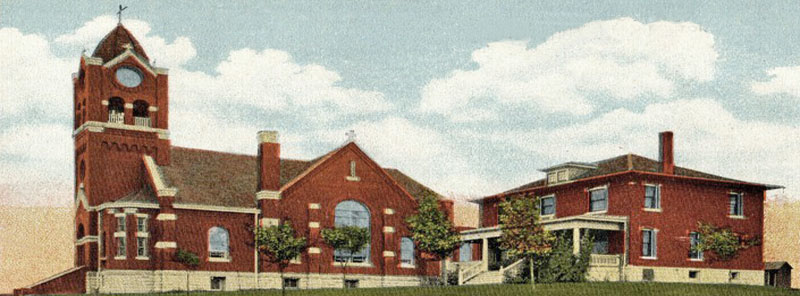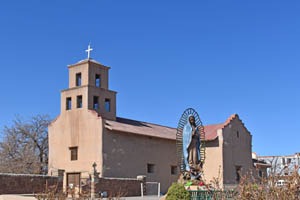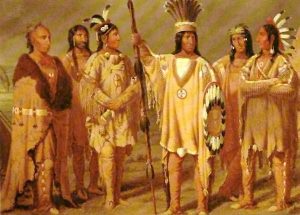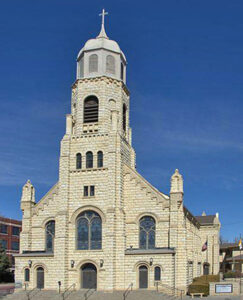The Catholic Church is one of the strongest religious organizations in the United States. Its history in the New World began in the year 1494, when 12 priests, commissioned by the pope, accompanied Christopher Columbus on his second voyage to America. The priests serving the Spanish colonies and the missionaries were under the jurisdiction of Saville until 1512 when San Domingo was erected and assumed control of religion in the new world. In 1522, another church was erected in Santiago de Cuba, and one in Mexico followed in 1530. These dioceses sent missionaries to evangelize the Indians of the southwestern portions of the United States. The southeastern area of what is now the United States was ecclesiastically dependent upon Santiago de Cuba and later Havana. Spanish missionaries, chiefly Franciscans, Dominicans, and Jesuits, established numerous missions in what are now the states of Texas, New Mexico, Arizona, and California. In 1565, a royal Spanish grant was issued to colonize Florida with the condition that 23 religious and four Jesuits be maintained. This colony founded St. Augustine, the oldest Catholic city in this country.
The first mission work in New Mexico was started by seven Franciscans in 1598 at San Juan, on the banks of the Rio del Norte, 33 years after the founding of St. Augustine. Priests were sent into the surrounding territory from this base, and the New Mexican missions were established. The period from 1650 to 1680 was the golden age of the New Mexican missions, where there were 60 members of the Franciscan order at once. Later, the Indians rebelled, burned, and destroyed the missions, but in time, the churches were restored, though they never gained as strong a foothold again.
In 1687, missions were established in what is now the State of Arizona by a Jesuit priest from Sonora. After 1732, St. Francis and St. Miguel became the centers of missionary work, and the Jesuits had charge until the Spaniards were expelled in 1767. With the close of Spanish dominion in Arizona, the history of the missions ceased as they became a part of the church of the United States. Spanish missions in Texas began in 1689 when three friars and a Franciscan established the San Francisco de Los Texas mission.
In 1769, an expedition left Mexico for California, and among its members were three Franciscans. A small chapel was erected at San Diego, the first step toward planting the Catholic church on the western coast. On June 3, 1769, the mission of Monterey was established by this same expedition. The Dominican order applied for permission to work in California. In 1773, the country was divided, the missions of lower California being entrusted to the order of St. Dominic and those of upper California to the Franciscans. The San Carlos mission became the residence of the superior and was the center of the mission work. The first report of the California missions was made in 1773 and showed that there were five missions—San Diego, San Gabriel, San Luis Obispo, San Antonio, and San Carlos. In 1775 the San Juan Capistrino and San Francisco missions were founded, and in 1777 Santa Clara mission. Forty-three years after founding the first mission, there were 18 missions in California. As a result of the Mexican Revolution, the missions were confiscated, and secular clergy replaced the friars.
While the Spaniards were establishing missions in the south and west, the French began the same work on the northeast coast, where the first religious establishment was made on Douchet Island, Maine, in 1604. The missions of New York were the result of work among the Huron Indians, the first mission being established at Oswego in 1654. In the west, the missions were located on the shores of the Great Lakes and the main waterways, and after the French discovered the Mississippi River, they established missions down that stream to the Gulf of Mexico.
As early as 1634, Jesuits were established in the Maryland colony, and after 1681, Catholics were tolerated in Pennsylvania. It was in these states that the first churches were established. After the American Revolution, many Catholic emigrants came from Ireland, and in 1790, the church of Baltimore was established. At that time, there were about 30,000 Catholics in the United States. By 1820, they had increased to 250,000, and during the next 20 years, the numbers were greatly increased by immigration. Through the great migratory movement west after the Revolution, the church was planted in the valleys of the Ohio and Mississippi Rivers, and from there, it crossed the continent, reaching the Pacific coast in the middle of the 19th century.
The church in the United States is part of the Catholic Church and subject to the same control and legislation as all other national churches. It is divided into provinces and dioceses. Each province is presided over by an archbishop, each diocese by a bishop, and the diocese is divided into parishes and missions with pastors appointed by the bishop.
Catholic mission work in what is now the State of Kansas was started in 1827 when Father Van Quickenborn, a Jesuit of Missouri, visited the Osage Indians in what is now southern Kansas. He made subsequent visits in 1829 and 1830. In 1847, Bishop Kendrick appointed Father John Schoenmakers superior of the Osage Mission in what is now Neosho County. During the Civil War, the mission was deserted, but at its close, work was resumed, and as many as eighteen Catholic missions were established. St. Francis school, monastery, and church were established and became permanent institutions.
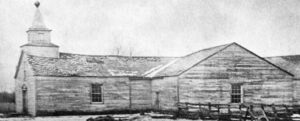
The Cathedral of the Immaculate Conception, St. Marys, Kansas, was the first Catholic cathedral built west of the Mississippi River.
In 1851, John B. Miege was appointed to the vicariate of all “the territory from Kansas River at its mouth to the British possessions and from the Missouri River west to the Rocky Mountains.” He had headquarters at St. Marys, and in 1851, he built the church of St. Mary of the Immaculate Conception, “the first cathedral of Bishop Miege, and the first church of any size in Kansas.” In 1855, he removed and established his church in Leavenworth. From St. Mary’s, priests ministered to the early settlers of Kansas after the territory was thrown open to settlement. In many cases, after churches were erected, the Jesuit fathers celebrated mass when there was no resident priest.
In 1855, there was only one Catholic bishop and a population of 700 Catholics in Kansas Territory. One of the earliest churches was organized at Leavenworth, where the Cathedral of the Immaculate Conception was established in 1851. It was built under the direction of Father Heiman, who was the first pastor. In 1854, it was consecrated by Bishop Miege. In 1857, St. John’s Catholic church was organized at Lawrence by Father Magee, with 15 members. Services were held in residences and public halls until 1860, when a church edifice was erected. St. John’s church was established at Doniphan in 1857, with Father Wirth being the first pastor. In 1862, St. Benedict’s church was organized at Severance by Father Thomas Barth, a Benedictine from Atchison. In 1858, Father Heiman of Leavenworth organized St. Mary’s mission at Wyandotte (Kansas City) with about 30 members. For some time, they met at the house of John Warren, but within a year, a church was built. The mission was abandoned during the Civil War, but at its close, the parish began to flourish, and in 1866, a new church was built.
The Catholic church at Valley Falls, Jefferson County, was established in 1858, but no building was erected for some time. In Nemaha County, St. Mary’s Catholic church was established in 1859 at Wild Cat, a settlement in Richmond Township. The Catholic church at Fort Scott was organized in 1860 through the efforts of Fathers Schoenmakers, Ponziglione, and Van Gach, and the first priest was Reverend J. F. Cunningham. The Church of the Assumption was organized at Topeka in 1862 by Father James H. Defouri, and the first church edifice, the oldest in the city, was completed in the same year. Father D.E. Mauritier, a missionary, established a church at Salina in 1866, the first pastor being Father Fogarty, the resident priest at Solomon City. At Ottawa, Franklin County, the Church of St. Joseph was organized by Father Guindon in 1869, and from that time, the church’s growth was rapid. According to the census taken in 1875, there were 233 Catholic organizations in the state, with 15 churches and a membership of 63,510, which included children of Catholic parents. By 1886, there were 75,000 Catholics in the state, with 259 church buildings. In 1906, the Catholic church ranked second in membership of all churches in the state, with 93,195 communicants.
Compiled and edited by Kathy Alexander/Legends of Kansas, updated March 2024.
About the Article: The text in this article comes from Kansas: A Cyclopedia of State History, edited by Frank W. Blackmar and published in 1912. However, the story as it appears here is not verbatim, as it has been edited for clarity and the modern reader.
Also See:

